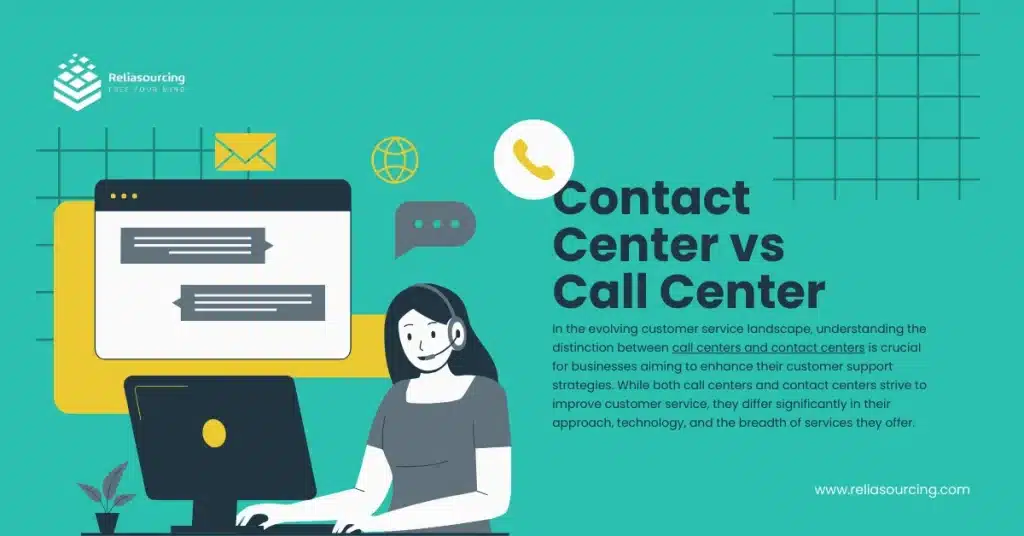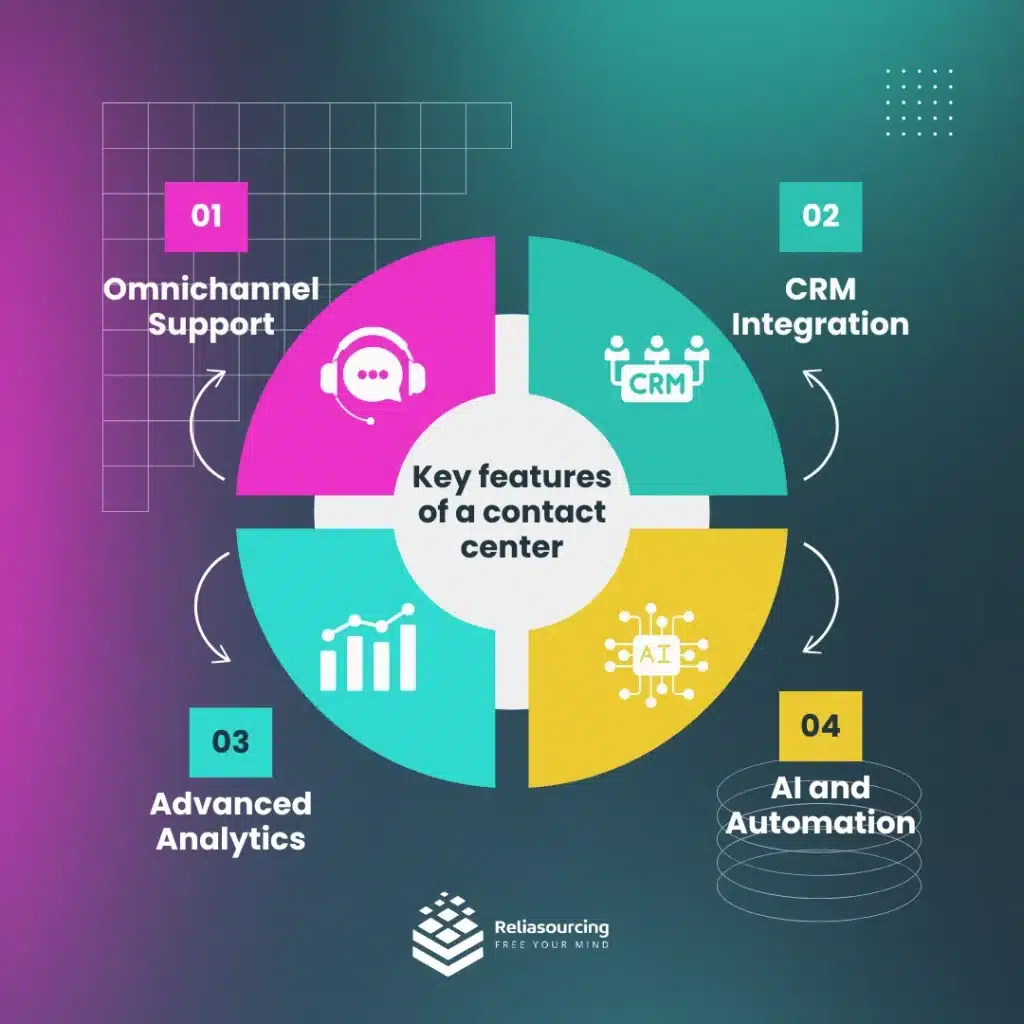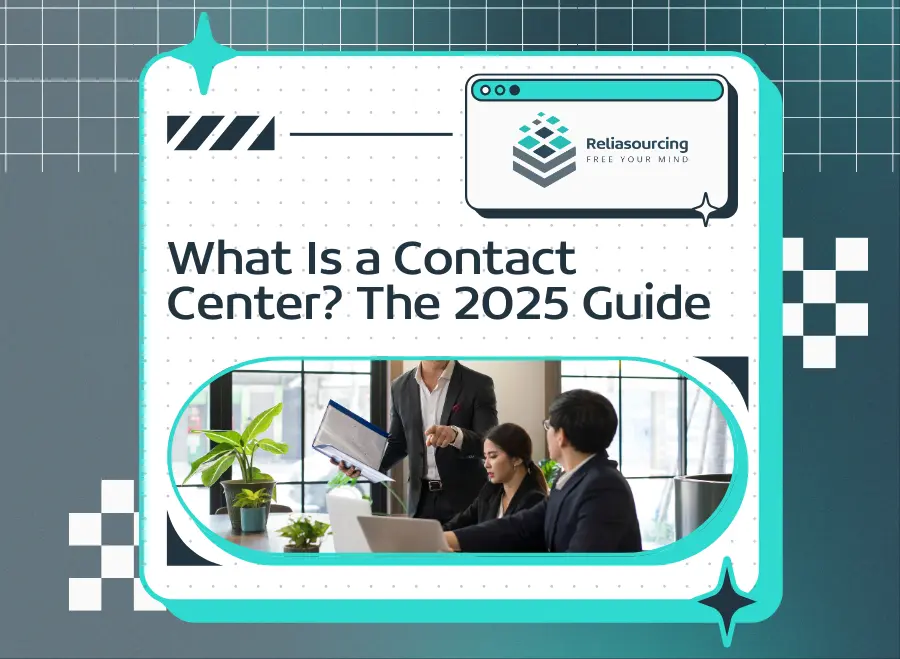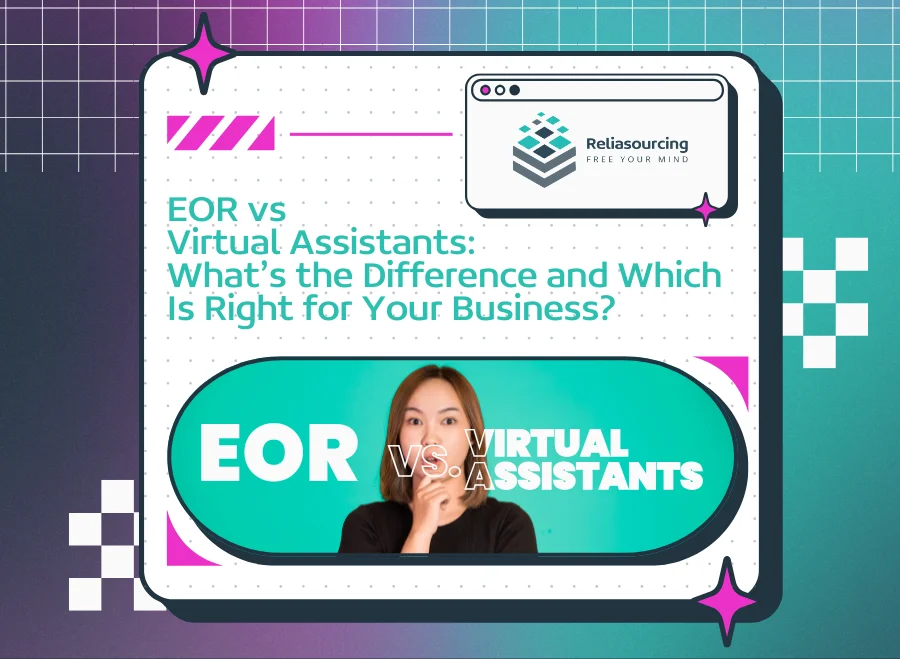What exactly is a contact center, and how does it differ from a traditional call center? Contact centers have become the backbone of exceptional customer service, helping businesses address growing demands for personalized support across multiple channels. For businesses, this means faster resolutions, personalized engagement, and the ability to anticipate customer needs—key factors in retaining clients and fostering long-term growth.
What is a Contact Center?
A contact center is a centralized department that handles inbound and outbound customer communications across multiple channels, including phone, email, chat, social media, and more. Unlike traditional call centers, which primarily focus on voice calls, contact centers provide an integrated, omnichannel customer service experience. This integration ensures that customers receive consistent support, regardless of their chosen communication method.
Comes in the internet revolution, transforming call centers into contact centers. As email, live chat, and social media became popular communication channels, businesses recognized the need for a more integrated approach to customer service. Contact centers emerged, offering a unified platform to manage customer interactions across multiple channels.
In 2025, contact centers increasingly adopt artificial intelligence (AI), machine learning, and automation to enhance their capabilities. AI-powered chatbots handle routine inquiries, while advanced analytics provide valuable insights into customer behavior and preferences. The shift towards remote and virtual centers continues, offering greater flexibility and cost savings.
Overall, contact centers have evolved into sophisticated customer interaction hubs, crucial in ensuring customer satisfaction and driving business success across diverse industries.
Contact Center vs Call Center

In the evolving customer service landscape, understanding the distinction between call centers and contact centers is crucial for businesses aiming to enhance their customer support strategies. While both call centers and contact centers strive to improve customer service, they differ significantly in their approach, technology, and the breadth of services they offer.
Communication Channels
- Call Centers: Handle voice calls exclusively. For example, a customer calling their bank to inquire about their account balance will be directed to a call center agent specializing in phone support.
- Contact Centers: Manage interactions through various channels such as email, live chat, social media, and more. For instance, a customer might contact a retail company’s center via live chat on the website for help with an online order. In contrast, another customer may use social media to ask a question about a product.
Technology
- Call Centers: Primarily use telephony systems for handling calls. This might include automated call distribution (ACD) and interactive voice response (IVR) systems to manage call flow.
- Contact Centers: Utilize advanced technology to integrate and manage multiple communication channels, providing a seamless customer experience. For example, a contact center agent can switch between a live chat conversation and an email thread with the same customer, ensuring continuity and efficiency in resolving issues.
Customer Insights
- Call Centers: Limited to collecting and analyzing data from voice interactions. This could involve monitoring call durations, call volumes, and customer satisfaction scores based on post-call surveys.
- Contact Centers: Gather and analyze data from all communication channels, offering deeper insights into customer behavior and preferences. For example, they can analyze social media interactions to identify trending customer concerns or use email analytics to measure response times and resolution rates.
Types of Contact Centers
Contact centers have evolved to address the diverse communication needs of modern businesses. Explore the various types, each designed to fulfill specific functions and customer service goals and highlight the critical job positions within these centers.
Inbound Contact Centers
Focuses on handling incoming communications from customers, such as inquiries, support requests, and complaints. These centers are designed to provide assistance and resolve issues that customers encounter with products or services.
- Customer Service Representatives (CSRs): Handle customer inquiries, provide information, and resolve issues.
- Technical Support Specialists: Offer technical assistance and troubleshoot problems.
- Help Desk Agents: Provide support for software, hardware, and other technical issues.
Outbound Contact Centers
Engages proactively with customers, including telemarketing, surveys, and follow-up calls. The primary goal is to reach customers for sales, feedback, and engagement purposes.
- Telemarketers: Conduct sales calls and promote products or services.
- Market Researchers: Perform surveys and gather customer feedback.
- Sales Representatives: Engage in upselling and cross-selling activities.
Automated Contact Centers
Uses AI and automated systems to handle routine inquiries and tasks, freeing up human agents for more complex interactions. These centers improve efficiency by automating repetitive tasks.
- Automation Specialists: Design and implement automated workflows and systems.
- AI Developers: Create and maintain AI solutions for handling customer interactions.
- Customer Service Managers: Oversee the integration of automated systems with human agents.
Virtual Contact Centers
Operates remotely, allowing agents to work from various locations. This model provides flexibility and cost savings, reducing the need for physical office space and enabling a geographically dispersed workforce.
- Remote Customer Service Agents: Provide support from home or remote locations.
- Virtual Team Leaders: Manage and coordinate remote teams.
- IT Support Staff: Ensure the technical infrastructure supports remote operations.
4 major benefits of a contact center
Contact centers play a crucial role in managing customer interactions and enhancing overall customer experience of businesses around the globe. Companies leverage not only on advanced technology and diverse communication channels that they provide but also the numerous benefits that help businesses thrive.
1. Enhanced Customer Experience
They offer multiple communication channels, including phone, email, live chat, and social media, allowing customers to reach out through their preferred method. This omnichannel approach ensures a seamless and consistent customer experience, leading to higher satisfaction and loyalty.
2. Increased Efficiency
Advanced technologies like AI and automation streamline processes, reducing response times and minimizing human error. Automated systems handle routine inquiries, freeing up human agents to focus on more complex issues. This not only improves efficiency but also enhances the quality of customer interactions.
3. Revenue Generation
Virtual contact centers and automation do more than just reduce costs; they also drive significant revenue growth. The scalability of these virtual modes allows businesses to handle higher volumes of customer interactions, opening up opportunities for upselling and cross-selling products and services. Outsourcing to offshore locations reduces labor costs and provides access to a larger talent pool, which can enhance service quality and customer engagement, further boosting revenue.
4. Scalability
There’s an ease of scaling operations to accommodate business growth and fluctuating customer demands. Whether it’s expanding the team or integrating new technologies, contact centers offer the flexibility to grow alongside your business.
Outsourcing these services allows businesses to focus on their core functions while experts handle customer interactions. This leads to increased efficiency and cost savings. Offshoring contact centers to regions like the Philippines provides additional advantages, such as access to a skilled workforce, 24/7 service capabilities, and significant cost reductions.
Businesses integrating this strategy into their operations enhance customer satisfaction, streamline processes, and achieve substantial cost savings with revenue generation. The strategic use of outsourcing and offshoring further amplifies these benefits, making contact centers an indispensable asset for modern enterprises.
Key features of a contact center

The modern contact center has a range of advanced features designed to enhance service delivery and operational efficiency. Here, we explore some of the key features that make them an indispensable asset for businesses.
1. Omnichannel Support
They seamlessly integrate various communication channels such as phone, email, live chat, social media, and SMS. This ensures customers can reach out through their preferred method, leading to a more unified and satisfying customer experience.
2. CRM Integration
Integrating Customer Relationship Management (CRM) systems, it centralizes customer data. This allows agents to access comprehensive customer profiles, enabling personalized interactions and more effective service.
3. Advanced Analytics
They can leverage advanced analytics tools to gather, analyze, and interpret customer data. These insights help businesses make informed decisions, optimize operations, and enhance customer satisfaction.
4. AI and Automation
Using AI-powered chatbots and automated systems allows contact centers to handle routine tasks efficiently. This improves operational efficiency and reduces human agents’ workload, allowing them to focus on more complex customer issues.
The future of contact centers
As the contact center industry embraces rapid transformation driven by technological advancements and evolving customer expectations, experts predict several key developments that will shape its future. Through these up-and-coming innovations, businesses can enhance their service delivery, operational efficiency, and overall customer satisfaction.
Artificial Intelligence (AI)
AI continues to revolutionize contact centers with advanced chatbots and virtual assistants. These technologies are becoming increasingly adept at handling complex tasks, from answering customer queries to processing transactions. As AI evolves, it will enable contact centers to offer more sophisticated and efficient customer support, reducing the reliance on human agents for routine tasks.
Omnichannel Integration
The future of customer service lies in seamless omnichannel integration. Contact centers increasingly incorporate various communication channels—such as phone, email, social media, and live chat—into a unified platform. This holistic approach ensures a consistent and cohesive customer experience, allowing customers to switch channels without losing context.
Remote Work
The rise of virtual contact centers has fundamentally changed the customer service landscape. Remote work offers greater flexibility for agents and reduces operational costs for businesses. With advancements in cloud technology and collaboration tools, virtual contact centers can maintain high levels of productivity and service quality regardless of their agents’ physical location.
Customer Personalization
Enhanced data analytics is paving the way for more personalized customer interactions. Contact centers can tailor their services to meet individual needs and preferences by leveraging customer data. This level of personalization not only improves service quality but also fosters customer loyalty and long-term engagement.
Outsourcing and Offshoring
Outsourcing and offshoring remain vital strategies for contact centers looking to thrive in the future. Partnering with specialized service providers in different regions allows businesses to tap into a global talent pool and reduce labor costs. Additionally, outsourcing allows companies to scale their operations quickly and efficiently, adapting to changing market demands without significant investments in infrastructure.
The future of contact centers is bright, focusing on technological innovation and strategic outsourcing. Staying ahead of these trends, contact centers remain competitive and capable of delivering exceptional customer experiences.
Frequently Asked Questions
How do you measure the success of a contact center?
The success of a contact center can be measured through various metrics, including customer satisfaction scores, average response time, first contact resolution rate, and overall cost savings.
What factors should be considered when choosing a contact center provider?
When choosing a contact center provider, you should consider factors such as the provider’s technology stack, experience in your industry, scalability options, pricing, and customer support capabilities.
Where are outsourced contact centers typically located?
Outsourced contact centers are often located in regions with lower labor costs, such as India, the Philippines, and Eastern Europe, providing cost-effective solutions without compromising quality.
How Reliasourcing helps with contact center outsourcing
Reliasourcing elevates customer service operations, empowering businesses to focus on growth by taking on essential support tasks, including customer service, sales, lead generation, and technical assistance. Here’s how Reliasourcing’s outsourcing solutions make a difference:
- Comprehensive Support: Provides customer, sales, lead generation, and technical support. Improves efficiency and service quality, ensuring a seamless customer experience.
- Global Reach: Offers multilingual, 24/7 support, making reaching and satisfying an international customer base possible. Ensures timely, around-the-clock support, building stronger customer relationships across different time zones.
- Revenue-generating Solution: Lowers expenses associated with maintaining an in-house team. Enables businesses to allocate resources strategically towards core areas of growth.
- Employee Satisfaction: Reduces the workload on in-house teams, alleviates pressure, and fosters a collaborative work environment. It also enables in-house staff to focus on strategic initiatives, enhancing overall team satisfaction.
Outsourcing also enhances employee satisfaction by alleviating pressure on in-house teams and fostering a collaborative environment. In summary, Reliasourcing’s contact center outsourcing boosts customer service, market reach, and operational efficiency, allowing businesses to focus on growth.
Summary
In summary, contact centers are pivotal in today’s customer service landscape, delivering seamless, omnichannel support that meets modern expectations. They offer a multi-channel approach to customer service that enhances the customer experience, improves efficiency, and provides valuable insights. As technology evolves, this strategy will play an increasingly important role in customer relationship management.
Overall, by partnering with Reliasourcing, businesses can optimize their customer service capabilities, reach wider markets, and sustain high standards—ultimately enabling them to focus on what truly matters: growth and innovation.
Ready to transform your customer service with a state-of-the-art contact center? Contact Reliasourcing today and discover how our solutions can elevate your business.









